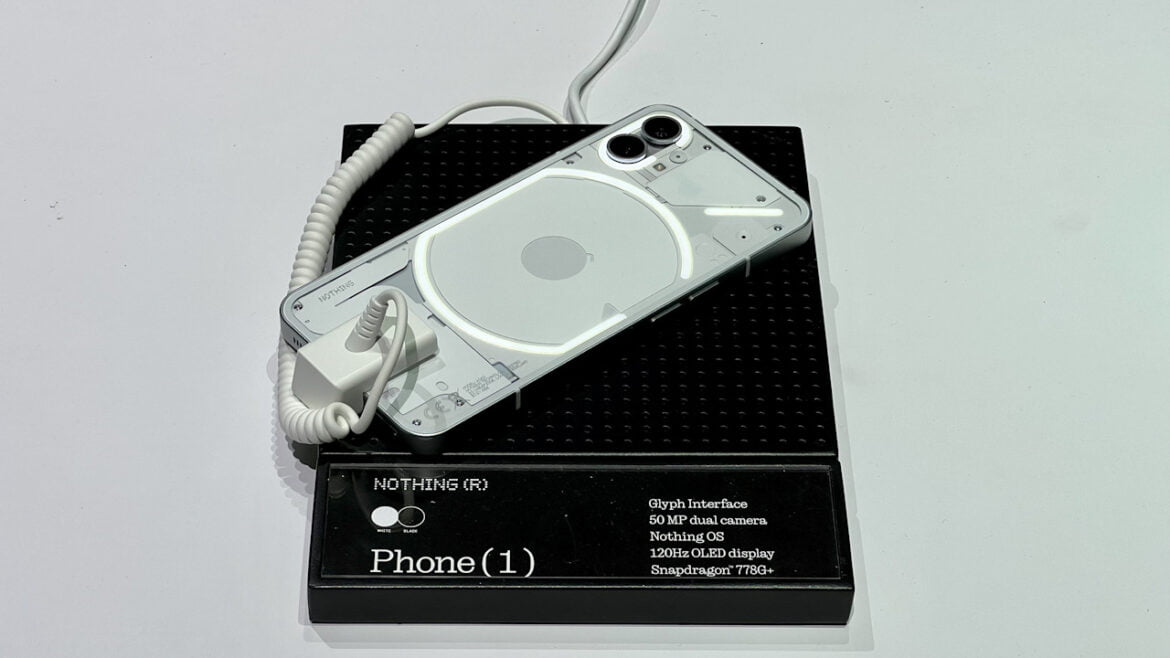The hype behind the Nothing Phone (1) is a clear [groan] reflection of the care the team put into the conceptualisation of the phone. But underneath the fanfare, it seems like Nothing actually has a decent mid-range smartphone in their hands.
If you’re old enough to remember and are wondering why it feels like early OnePlus, it’s probably because Nothing founder Carl Pei was one of the co-founders of the innovative upstart that made waves early in the last decade.
The Nothing concept is grounded in creating a phone distilled to its essentials; not quite unlike what Google does with Pixel, but with its own identity and ideals. That thinking also extends to the now somewhat fashionable realms of sustainability efforts, where the Phone (1) leads the way by virtue of its frame made from 100 per cent recycled aluminium and over 50 per cent of the phone’s plastic made from bio-based or post-consumer recycled materials.

If looks could kill your wallet (but not too much), this is it.
Much of the Phone (1)’s charm lies in its design; a breath of fresh air amongst the unadventurous smartphone designs of today. The rear is deliberately made transparent, revealing 400 or so components that were designed with aesthetics in mind, even to the extent of throwing out nods to iconic motifs like Massimo Vignelli’s classic subway system signage.
If anything, Nothing’s design alone should seal the deal but the internals of the Phone (1) aren’t too bad either.
Well-specced midrange phone
At its heart lies a Qualcomm Snapdragon 778G+ chipset, customised to enable wireless charging (and reverse charging).
The 6.55″ OLED display supports HDR10+ as well as 120Hz refresh rate while the speakers are tuned by Dirac (Dolby’s competition). Nothing makes a big deal about the fact that they use a flexible OLED panel over a rigid one so that they can get the bezels to line up evenly.
The cameras are quite well-specced as well: a 50 MP (Sony IMX766) wide angle main camera and a 50MP (Samsung JN1) ultra-wide angle camera (with 4cm macro) adorn the rear, with a 16MP (Sony IMX471) camera at the front. For the most part, image quality for smartphone cameras is mostly down to software, and the Phone (1)’s camera is OK judging from first impressions–Google Pixel 6a won’t be losing any sleep–but we have to wait and see if Nothing can improve on this performance with updates. However, do note that video capture performance is limited to 4K30fps.
Glib or Glyph?
The Glyph Interface is what captures the attention of most people. The unique motif on the back of the phone, which is made up of 900 LEDs, is demarcated into components that light up individually to indicate a variety of events ranging from incoming calls, to app notifications, charging status and more.
Each of the preset ringtones has a unique Glyph pattern, which you can assign to your most important contacts so you can identify them without having to check your phone constantly. The Flip to Glyph mode switches the phone into Silent mode with lights-only notifications when you place it face down.

Nothing wants you to put your phone face down.
It’s also a deliberate move to display its iconic design on top of showing off its eye-catching Glyphs. Audibly, it’s silent, but visually, it’s pretty ‘loud’. The lights are also pretty handy as a makeshift ring light, which should be pretty useful for close-up photos.
‘Nothing’s gonna strop OS now’
The other noticeable differentiator is Nothing OS, the company’s streamlined take on Android, which they say “delivers only the best of Android” at starship speeds. Aside from the distinctive design language that extends to the bespoke widgets, fonts, sounds and wallpapers, the snappy response will undoubtedly grab your attention.
It also features third-party brand integrations to control settings. For example, you can unlock doors, turn on AC, check mileage and more for your Tesla. Nothing says that more collaborations will be announced soon.
Other features include a native NFT gallery to display your NFT collection and track floor price from the home screen, and a Game Mode that switches your phone settings to create a more immersive environment.

The charging coils are an integral part of the phone’s aesthetic.
As mentioned the Nothing Phone (1) was tweaked to support 15W wireless charging and 5W reverse charge, which means that it ‘natively’ supports the Ear (1) as a battery pack (yes, the charging coil Glyph lights up when you do it). There’s also the good ol’ wired method (33W fast charging), which charges the phone to 50 per cent in 30 minutes.
Nothing claims 18 hours usage and two-day standby with a full battery, and part of it is down to its algorithms and machine learning that prioritises your most-used apps to ensure that they load quickly, while freezing the rest to save battery.
Three variants of the Nothing Phone (1) will be available in Singapore: 8GB/128GB ($769 SGD), 8GB/256GB ($869 SGD), and the 12GB/256GB ($949 SGD). The are two colours, black and white, though 8G/128GB model is only available in black. Pre-orders for Nothing Phone (1) start on 5 Aug 2022 and will end on 12 Aug 2022, while open sales start on 13 August 2022. It will be available from M1, Challenger, Lazada, Limited EDT and Zym.
